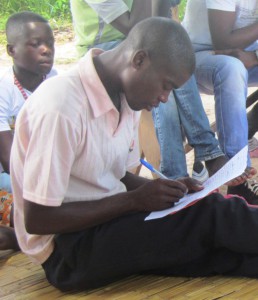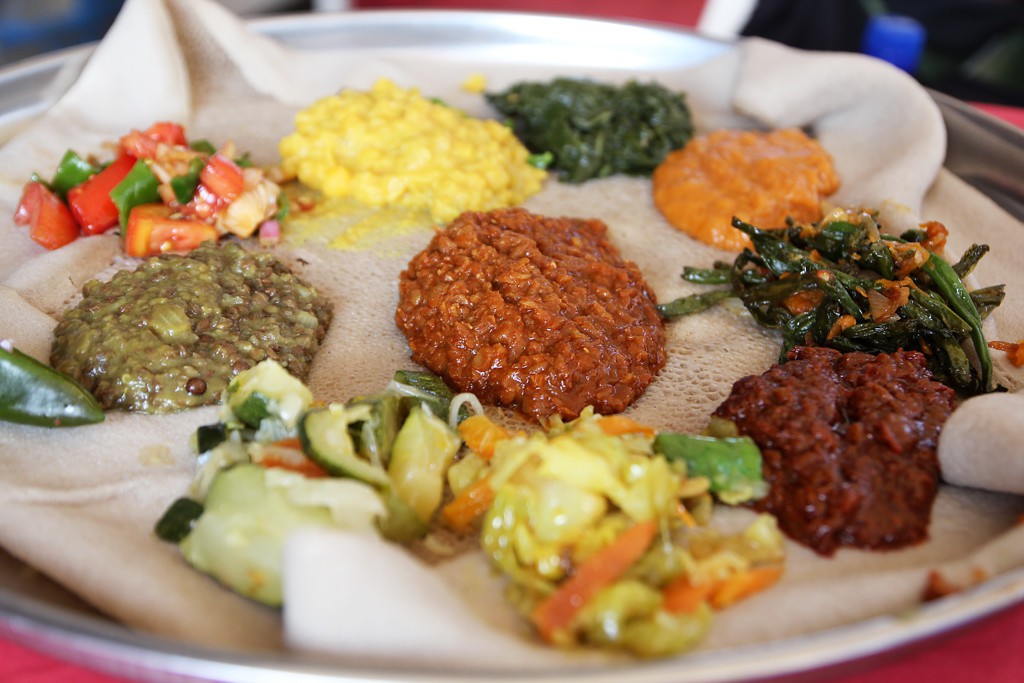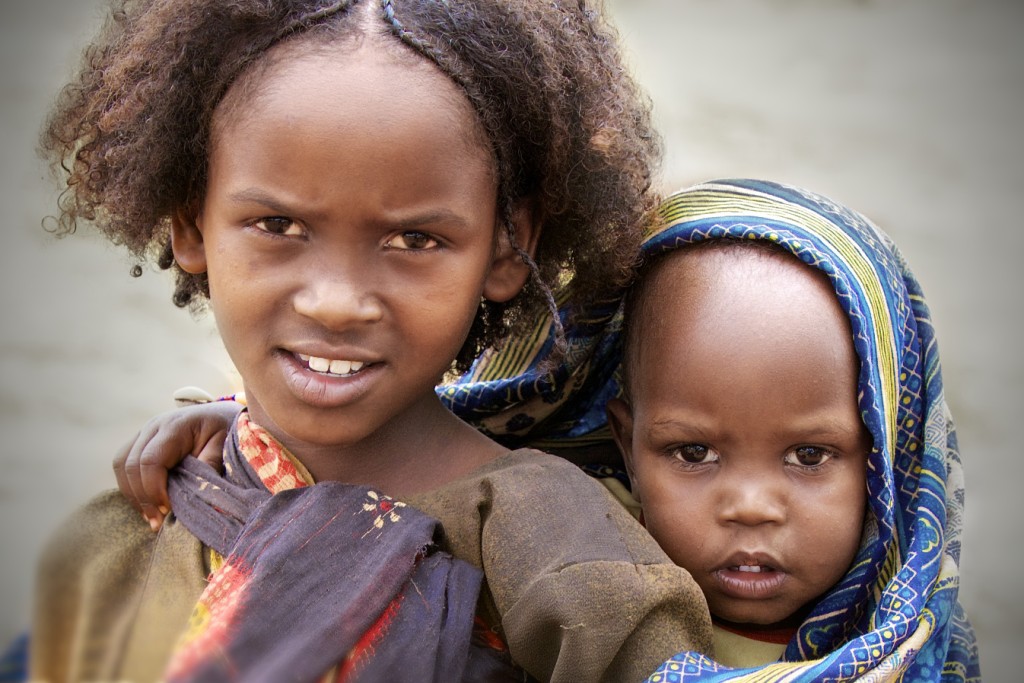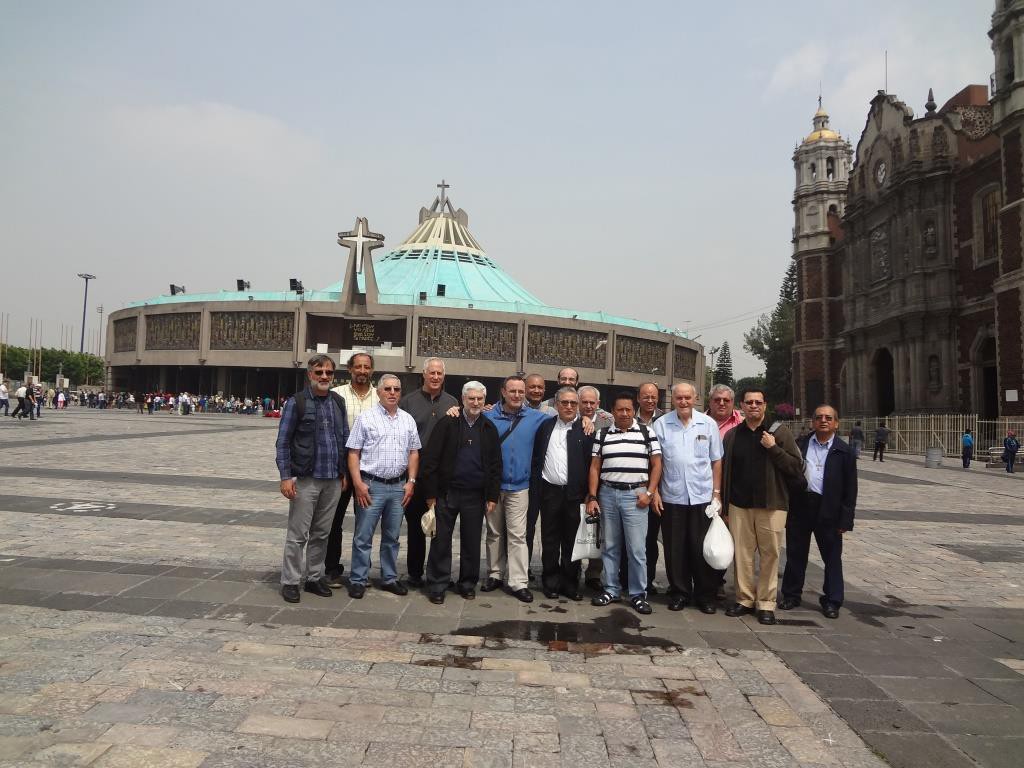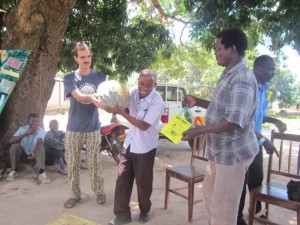Peoples and Cultures
The Ethiopian “Gursha”
During lunch time, at the clinic where I serve, I (Maggie) eat routinely with four of my coworkers. They each bring their lunch from home – injera (Ethiopian spongy bread) wrapped around wot (stew) which fits the square little Tupperware perfectly, and even stays in the shape of a square when dumped out. Surprising to me, instead of each eating their own lunch from home, they grab one dinner size plate and in sequence dump their cubes of injera/wot on top of each other forming the “Leaning Tower of Wot”. Then they eat collectively, sampling and sharing everything. It is a letting go of what is theirs, and a welcoming in of friendship and fellowship.
In Ethiopia, food is always shared, and typically eaten like this from one large platter without the use of cutlery. Even strangers will be invited with a simple “Enebela!” (let’s eat!). To me it is fun and new and means simple clean-up and virtually no dishes but to Ethiopians the tradition is much more deeply rooted, and follows their saying: “those who eat from the same plate will not betray each other.”
During lunch hour I am typically the recipient of the gursha. The “gursha” is a traditional custom that Mark and I initially found quite peculiar. En route to Ethiopia we read about it in a culture book, and were curious yet nervous about the moment when we would experience our first gursha and how we would respond. Gursha is when another person who is dining with you, unrolls a strip of injera, wraps it around a tasty bit of wot and then feeds you directly by hand. It is the final breakdown of the notion of personal space! The trick is to take it without letting your mouth come into contact with the person’s fingers and without letting the food fall. One gursha is considered unlucky so it always repeats. I think Mark and I each received our first gursha from our homestay sisters. Since then I have been a regular gursha receiver and while it is still slightly peculiar I quite enjoy it. I haven’t yet mastered the fine art of wrapping and dipping my injera properly to soak up the spicy wot so when my work colleagues feed me a bite of wot which they have personally selected it is much more delicious that what I have been feeding to myself! Some days I receive so many gurshas that I don’t even need to eat on my own. Not only is it tasty but it is also a sign of acceptance, like a hug between friends. It’s a simple way to say I appreciate you.
A friend once said: “If you bring me to an Ethiopian meal, you are friend enough that I will gladly feed to you my first mouthful of food. If I am lucky you will feed to me your last — and if I am not, I have still profited the messy wonder of an Ethiopian meal.”
– Mark & Maggie Banga
Comboni Lay Missionaries serving in Awassa, Ethiopia
My name is “She Rained Down”
Names have a unique significance and richness in Ethiopia and the naming of a child may come about in a few different ways. The country’s ancient Christian roots reveal themselves to this day in the naming of many new babies. As among other Christians throughout the world, it would be common to name a child after a person in the bible, one of the apostles or a saint. For example, common names here are Hanna,Solomon, Isaac and Yohannes (John).
But what is also common and beautifully unique here is that many Ethiopian names are compounds or small phrases rather than one word. Some examples of compound names are:
Ehitnesh – You are a sister
Terunesh – You are wonderful
Serkaddis – Always new
Zenebetch – She rained down
Engedawerq – Golden guest
Yibeltal – He is above
Yemiseratch – She who works
Nega – It became dawn
The meanings sometimes reveal the circumstance of the child’s birth, a personality trait that the parents see in the child or an aspiration of the parents for their child. For example, the name Tesfaye which means “My Hope” is frequently given by a mother who is very poor or single reflecting her hope for her child’s future goodness and success. Or a name like Mitiku meaning “Substitute” would be given to a child after the death of a brother or sister. One of our friends is named Teshale which means “He is feeling better” because he was born sick but pulled through.
Many compound names may also stem from the parents faith and reflect one of God’s characteristics. They are given to give reverence and thanks to God for the gift of the new life into this world, for example:
Meheretu – His Mercy
Gashow – His Shield
Mebratu – His Light
Gebre Mariam – Son of Mary
Habte Mikael – Gift of Micheal (if the parents had prayed to St. Michael the archangel for a baby)
Another unique feature is that there are no surnames. The tradition is that the first name of the child’s father becomes the child’s last name. Since my fathers name is Alex Banga, had I been born in Ethiopia I would have been named Mark Alex instead of Mark Banga. Also, a woman never takes her husbands name in marriage, instead she keeps her fathers first name.
Because the Amharic names still sound ‘foreign’ to our ears we don’t notice how different the names are. Meheretu enters our mind as Meheretu and is quickly classified as a foreign word, not decoded into its Amharic meaning. But if we stop to think about what we are hearing it’s quite peculiar for us. The compound names shown above do not symbolize the meaning but are in fact the literal words. Just imagine if you overheard this conversation:
“Good morning His Shield”
“Hi You are Wonderful, how are you doing? Did you see My Hope last night”
“No, My Hope did not come to the party but He is feeling better was there with his new girlfriend She is sister.”
The names have on one hand been helpful to learn Amharic, because we have not needed to remember a lot of names as new vocabulary. We can translate someone’s name into the literal meaning which both reinforces the Amharic grammar and helps us remember their name. Bonus! But on one hand it has been difficult. Perhaps in reading the little conversation above you were confused? This often happens to us for example when listening to the radio. We are not always sure if the broadcast is about the government or if the person who is being interviewed is named The Government! Also several names can be used for both boys and girls. For example, Tesfaye – My hope or Fiqere – My love.
As for our names, although Maggie is a short name and easy to spell in the Amharic alphabet (only 2 characters!) there is no equivalent or similar Amharic word so they struggle a little to remember it. We have found it funny that if Maggie says her long name with a Spanish twist and calls herself Margarita they have no trouble remembering! But for me, there is no easier name to recognize under the Ethiopian sun than one of the Gospel writers, Markos.
– Mark & Maggie Banga
Comboni Lay Missionaries serving in Awassa, Ethiopia
Mgr. Romero, a life and mission model for the Comboni Missionaries of America
The delegates from America and Asia to the XVIII General Chapter, meeting in a continental assembly in Mexico City from 11 to 15 May, share their approach and reflection through an open letter addressed to those responsible for the Comboni Family on the occasion of the beatification of Mgr. Oscar Arnulfo Romero, to be celebrated on Saturday, 23 May, in El Salvador. Below is the letter of the missionaries.
Open Letter
from the Comboni Missionaries of America/Asia
on the Occasion of the Beatification of Bishop Romero
Dear Brothers and Sisters,
As the delegates from America and Asia to the XVIII General Chapter we greet you fraternally. We wish to express our closeness to you and to share with you our reflections on the Beatification of Bishop Oscar Arnulfo Romero (Saturday, May 23, 2015). Without doubt this is an historic event of great importance for our Church. For this reason we would like to share our reflections on some aspects of this event:
- The solemn beatification by the universal Church confirms what our people already believe and celebrate: Romero is a martyr. In this beatification we also celebrate the gift of their lives offered by so many other martyrs whose struggles we have perhaps never known about. We admire the courage and fidelity of those who will be beatified in Peru this coming December: Fr. Zbigniew Strzalkowski, Fr. Michael Tomaszeck and Fr. Alexander Dordi, victims of terrorism, as well as of hundreds of committed lay persons, catechists, men and women who obstinately defended human rights; they were adults, the elderly, youth and innocent children, religious and priests martyred for the love of Christ, the Church and the people in societies that regard themselves as Christians. The Reign of God is proposed to all to become the commitment of all. Like them Bishop Romero was a victim of the forces of evil embodied in the alliance of the economic, political and military powers that hold on to their illegitimate privileges against the struggle of the oppressed for freedom.
- In a time of rapid and great changes in which we are called to rediscover the prophetic dimension of our faith and consecration, we wish to reaffirm that Bishop Oscar Arnulfo Romero is a model prophet for our time. The suffering of our defenseless brothers and sisters, violence in all forms that is increasing everywhere, and criminalizing human rights defenders are challenges to our prophetic commitment today.
- To be a martyr cannot be improvised. With this affirmation we mean to highlight the profound mystic quality of Bishop Romero that was forged in the daily prayer by which he lived out his being a Christian, priest and pastor. His priestly spirituality is manifested in his Episcopal motto: “Sentire cum Ecclesia”. However since all spirituality is a journey of growth and docility to the Spirit, the martyrdom of Fr. Rutilio Grande, SJ and the violence carried out by the military against the people, mark his process of conversion: from indifference/comfort to solidarity with the poorest and oppressed.
- In Bishop Romero we discover the image of the Good Shepherd who fully identifies with his people and who suffers in his own flesh the abuses against the dignity of persons, who raises his voice to condemn injustice and preach peace, who prays for his brothers and sisters and loves them so much that he willingly gives up his life in the firm hope that his death will be a source of life for the Salvadoran people.
- What meaning does this ecclesial event have for us today? The beatification of Bishop Romero presents him as a model of life and mission:
- Interpreting reality in the light of faith should bring us to a personal and community conversion;
- Evangelization includes commitment to the integral liberation of persons and peoples;
- The evangelizer identifies in a radical way with the situation of the people in their sufferings and hopes;
- The values of the Reign of God are always the utopia that enlightens the path of our missionary service;
- Giving one’s life for the sheep gives tangible form to our vocation to follow the pierced Heart of the Good Shepherd who gave his life for his sheep.
Finding security as we trust in the words of the Gospel: “If the grain of wheat does not fall into the ground and die, it remains alone; but if it dies it produces much fruit” (John 1224), we want to invite you to create a new path of renewal and hope for ourselves and our peoples. In communion with all of you, in memory of Bishop Romero and of all the martyrs of America, and in particular Fr. Ezekiel Ramin, we firmly believe that the XVIII General Chapter that is now approaching offers us all an opportunity to renew ourselves in faithfulness to the charism of St. Daniel Comboni and in imitation of the martyrs of our church in America.
Mexico City, May 15, 2015
[Mozambique] Missionary Animation in the Parish of the Holy Cross

The fourth weekend of each month, the CLM in Mozambique, have the habit of meeting for basic training and lifelong learning. These meetings are mainly for training but on certain occasions a parish is chosen for Missionary Animation. As it was done this March 28, in the Parish of the Holy Cross, in the city of Nampula, starting on Saturday afternoon, we presented ourselves at a group of this parish, consisting of singles and young couples.
 We share the word of God and we talked about the movement of the CLM at the level of Mozambique and in the world. Deepening phrases of St. Daniel Comboni who says: “Save Africa with Africa”, “I die, but my work will not die”, “thousand lives for a mission,” “The works of God are born and grow at the foot of the Cross “; all this was cause for our reflection.
We share the word of God and we talked about the movement of the CLM at the level of Mozambique and in the world. Deepening phrases of St. Daniel Comboni who says: “Save Africa with Africa”, “I die, but my work will not die”, “thousand lives for a mission,” “The works of God are born and grow at the foot of the Cross “; all this was cause for our reflection.
 Once finished on Saturday, on Sunday 29, we were in the community of San Juan de Brito, which belongs to the same parish where our animation culminated with much joy and coinciding with Palm Sunday. Where is celebrated the day of youth. At the end of the celebration, we met to continue talking about our movement, particularly the activities in the parish of Carapira and the Industrial School.
Once finished on Saturday, on Sunday 29, we were in the community of San Juan de Brito, which belongs to the same parish where our animation culminated with much joy and coinciding with Palm Sunday. Where is celebrated the day of youth. At the end of the celebration, we met to continue talking about our movement, particularly the activities in the parish of Carapira and the Industrial School.

Therefore, after the presentation of the phrases of St. Daniel Comboni, we mentioned above, people with the need to reflect, requested the translation in their local language (Macua). Among other translations, focused heavily on “Saving Africa with Africa” in macua “Wopola w’África nor Africa”. They gave various examples. Believers of this community were moved from this animation, having the need to be more informed. So, we left an opening dialogue through our contact.
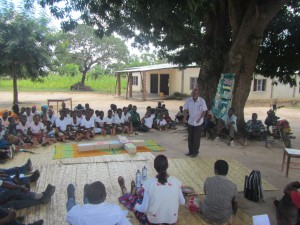
Another important aspect that we talked about was the family that is rich because today has Priests, Brothers, Sisters Laity and secular.
By last, we appreciate the availability and receipt of the parish, and this community. At the end they still offered us some products of “machamba” (orchard).
By Rui Evaristo Assane, CLM candidate
